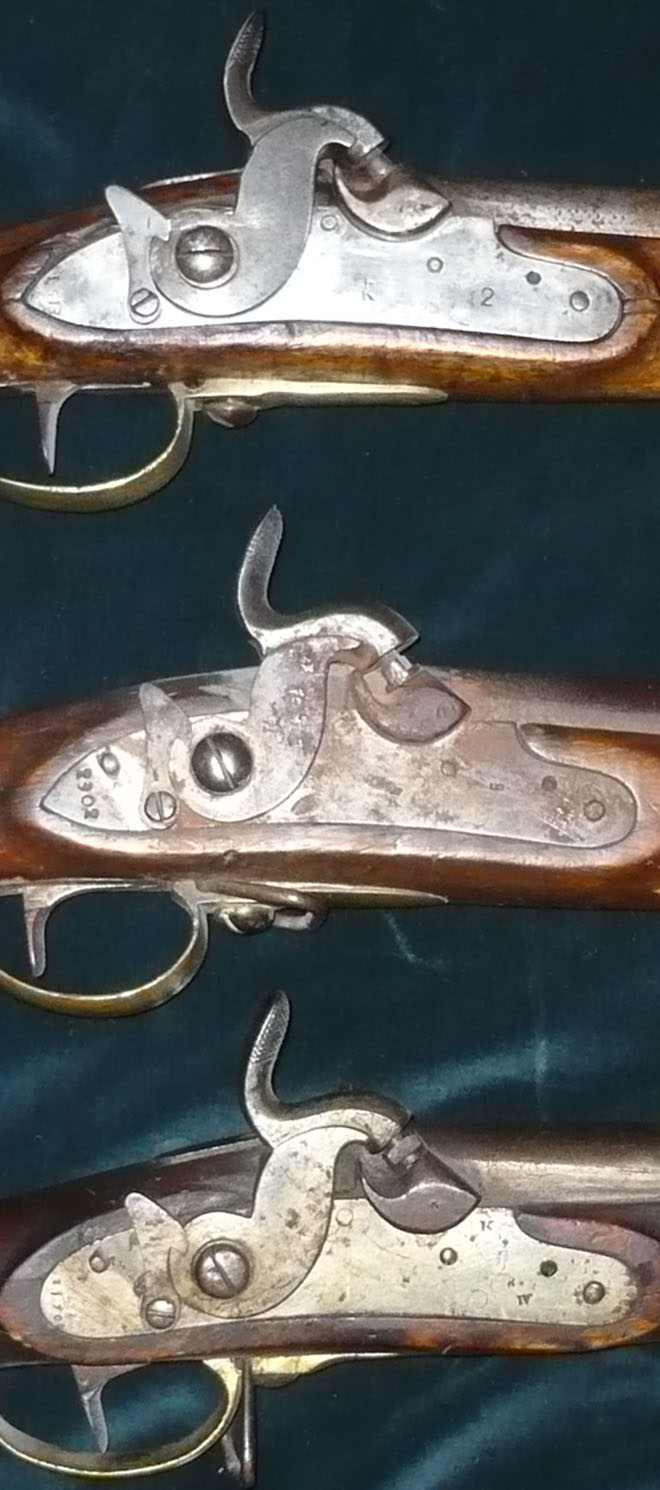M1825/41 & 1829/41 Infantry musket
I have chosen to show these two together as they are almost identical and most of the M1825 were converted to M1829.
The smooth-bored Kongsberg infantry musket M1825 is really an almost identical copy of the Swedish M1815, but a lot more scarce. I have actually never seen any of the Norwegian M1825, M1829 or M1834 in flintlock version in private ownership. Come to think of it, the only privatly owned percussion conversion in full length with the original M1825 stock I can remember ever having seen, is the one I have!
 The Norwegian M1825 in percussion placed beside a flintlock Swedish M1815. Of noticable differences is that the Norwegian musket has a middle band that is wider on the underside and that the Swedish musket has a shallow hollow on the left side of the shoulder stock. The Swede is some 10-15 mm longer than the Norwegian and there were some minor differences on the flintlock, the lockplate having sides slightly rounded on the Swede. Both long-guns have one thing in common making them difficult to identify – most of them have no marks on the original flintlock version. Kongsberg stamped a crowned “K” when converting the Norwegian musket to percussion in 1841.
The Norwegian M1825 in percussion placed beside a flintlock Swedish M1815. Of noticable differences is that the Norwegian musket has a middle band that is wider on the underside and that the Swedish musket has a shallow hollow on the left side of the shoulder stock. The Swede is some 10-15 mm longer than the Norwegian and there were some minor differences on the flintlock, the lockplate having sides slightly rounded on the Swede. Both long-guns have one thing in common making them difficult to identify – most of them have no marks on the original flintlock version. Kongsberg stamped a crowned “K” when converting the Norwegian musket to percussion in 1841.
Kongsberg Våbenfabrik (arms factory) was established in 1814 and had only produced limited quantities of the M1818 flintlock pistol and the M1821 jäger rifle before starting on the M1825 smooth bored infantry musket. These three first guns are not marked with the later used crowned “K”, but some of them had the text Kongsberg V.F. on the barrel.
The stained birch stocks of the M1825 was carved by farmers in Nummedalen in winter-time. Quality on these became a problem and Kongsberg decided to employ craftsmen at the factory for later production of stocks. As a result, many of the M1825 had new stocks fitted and these usually were the M1829 stock. It might therefor often be difficult to decide if a musket is the M1825 or the M1829. If you guns both guns together, bra brass mounts on the M1829 are a lot thinner than on the M1829.

 The safety catch on the M1825 has a little steel rod on the inside, going against the lock plate. There is carved a track for this in the stock. The same catch is used on the M1829 converted M1825’s. On the M1829 & M1834 the safety catch is stopped against a little steel rod attached to the face of the lock plate.
The safety catch on the M1825 has a little steel rod on the inside, going against the lock plate. There is carved a track for this in the stock. The same catch is used on the M1829 converted M1825’s. On the M1829 & M1834 the safety catch is stopped against a little steel rod attached to the face of the lock plate.
In the picture to the left are the lock plates for M1825, M1829 & M1834. The two first are pointed in the rear, the M1834 rounded. One can also see the little rod sticking out behind the dog catch on the two bottom ones. Click the pictures.
The angle of the butt plate is the same on the Swedish M1815 and the Norwegian M1825, but was changed from 79 degree to 72 degree on the M1829 and M1834.
All these Kongsberg infantry muskets were made as flintlocks, but just about all of them were converted to percussion in 1841. The muskets in best condition were converted to pillar breech rifles in 1851, in 1860 a number of the better remaining muskets were converted to shortened down pillar breech rifles.
The muskets that had seen a serious amount of wear and tear were shortened down and used for drill and exercise muskets. Se the different variations under the M1834.
I’m always interested in more Kongsberg infantry muskets/rifles, so if you by chance should have one, please mail me at .

